Investigators suspect metal
linked to deadly crashes
Questions were raised about parts made at Springfield

|
©1999 Dayton Daily News In early 1994, Brett Roby wore something special to work at SPECO, a now-defunct factory in Springfield that produced military aircraft parts for more than 50 years.
He wore a wire.
Department of Defense investigators planted the hidden microphone underneath Roby's clothes after he raised questions about the safety of American soldiers flying on the CH-47D Chinook, the U.S. Army's chief transport helicopter.
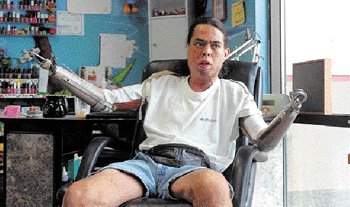 DAN MCCOMB/FOR THE DAYTON DAILY NEWS 'I DIDN'T WANT TO look at myself. At one time, I broke down. I didn't have any hands,' said Paul Patricio, who was severely burned when a CH-47D slammed into the ground. Of the 19 people on board, 10 were killed. 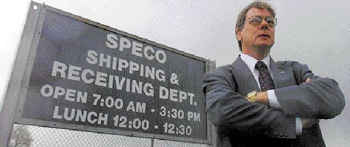 SKIP PETERSON/DAYTON DAILY NEWS 'I HAD PEOPLE COMING to my desk asking me what the hell I was doing,' said Brett Roby, who had been a quality assurance inspector at SPECO only six months when he requested that all grinding on Vasco gears be stopped. |
"I was raising a lot of hell about the possibility that we had a material that was unstable," said Roby, a former Dayton resident now living in Arkansas.
A team of federal investigators in Washington, D.C., and Dayton and Roby's private attorneys in Cincinnati now suspect four accidents that killed seven people may be linked to gears made with the metal. Records, released after being kept under seal for years by a federal court, show investigators also have tried to link at least three other crashes that killed 13 people to the gears.
And in August, more than five years after Roby went to federal investigators, armies worldwide grounded hundreds of Chinooks after a British Royal Air Force maintenance facility in Scotland found grinding cracks in gear parts made with the same metal.
The U.S. Army initially grounded its entire fleet of 466 CH-47Ds, the most Chinooks ever put down at one time.
The metal, Vasco X2M, was first used on helicopter gears by Boeing, which patented a process to heat-treat the metal. Vasco was used on gears that power the eight 25-foot rotor blades on the Chinook, the first production aircraft to fly using the metal.
"Because Boeing invented this and had the patent rights and was trying to make a market for this material, (Boeing was) trying to use the Chinook as a guinea pig to show that this material could be used in aircraft applications," said Roby's attorney, James B. Helmer, Jr., of Cincinnati.
The investigation into the failures of Vasco-made gears in the CH-47D helicopters illustrates one of the most significant anomalies in military aviation: Private aircraft companies are allowed to help -- relied on heavily in many cases -- determine the official causes of military aviation accidents, even though the same companies can face up to hundreds of millions of dollars in civil judgments and penalties that may hinge on what the official causes of the accidents are determined to be.
In this case, as Boeing was faced with lawsuits questioning the safety of its products, it was allowed to examine evidence and play other key roles in helping the Army decide if those same products were endangering the lives of American service personnel.
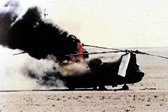 |
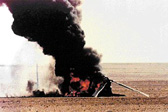 |
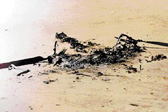 |
|
A SERIES OF PHOTOS shows a CH-47D burning in the desert of Saudi Arabia on Jan. 11, 1991. The helicopter was 15 to 20 feet above the ground when smoke poured from an area near an engine. As the forward wheels touched the sand, the rear of the helicopter exploded. The 18 passengers and crew members were able to escape, just as the ammunition inside exploded and fire destroyed the aircraft. | ||
The suit alleges that Boeing, the world's largest aircraft manufacturer, violated federal and common law because it "sold, or caused to be sold," defective helicopter gears to the Army. The Justice Department has joined Roby in the legal action, and the government is seeking hundreds of millions of dollars from Boeing for the cost of destroyed or damaged helicopters and replacing gears in existing helicopters.
SPECO was one of four companies that made gears or gear parts using Vasco for the CH-47D. Boeing also contracted with Litton Precision Gears of Chicago, now Boeing Precision Gears, which used SKF Industries of Philadelphia and MRC Bearings of Jamestown, N.Y., to manufacture bearings for the gears.
Although Roby's lawsuit deals only with SPECO-made gears, the investigation has expanded to include accidents involving aircraft with gears made at Litton. In addition, faulty gear parts machined at MRC are linked to the current groundings.
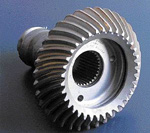
| THE TOP PHOTO is engine transmission gear 145D6301, the same part number suspected in the Jan. 11, 1991, CH-47D Chinook helicopter crash in Saudi Arabia. The cross section is gear 145D6302, the part number at issue in the June 24, 1993, crash in Maryland. The cut portion is the gear's dampening ring groove, where a crack suspected of causing the gear failure initiated. Both gears are located outside the fuselage at the front of each engine. |
Both the Army and Boeing defended Vasco.
"When Vasco is manufactured according to specifications and made into gears correctly, the Army has verified that it is safe for use in the helicopters," a prepared statement from the Army says.
Boeing officials deny that any Litton-made gears were linked to crashes. They acknowledged that some SPECO gears and gear parts machined at MRC were faulty, but they blamed the problem on human error, not on Vasco.
From time to time, manufacturers produce faulty gears, Boeing officials said, but inspections are supposed to identify bad gears. Both SPECO and MRC failed to identify the problem gear parts through inspections, the officials said, and that caused the problems.
"They (the problems) should have been caught," said Boeing attorney Mitchell S. Ettinger of Washington, D.C., during an interview at a Boeing's corporate office in St. Louis.
John Bozogan, vice president of quality assurance and engineering for MRC Bearings, said the company performed inspections exactly as it was told by Boeing. But, he added: "At the time, Boeing was modifying the inspection requirement."
Asked about the grinding cracks that led to the current grounding, Bozogan said: "We are concerned that we did not find them."
